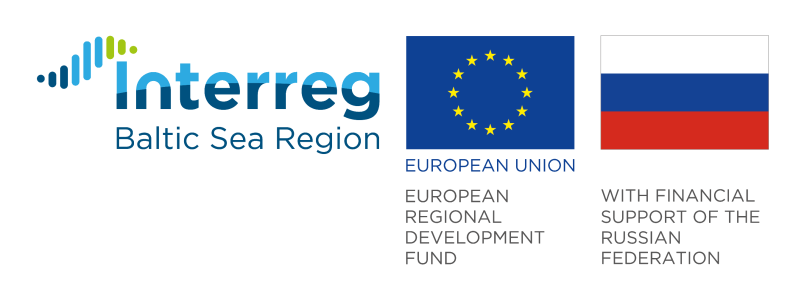How and why can policymakers help to speed up transition with circular design? The "EcoDesign Circle 4.0" consortium gathered recommendations, supportive information and readings and interesting numbers.
picture on top: Signing a memorandum on cooperation for a circular economy in St. Petersburg, Russia (March 2021) | Elena Gontarenko
-
1. POWER OF DESIGN
Design is not only “about aesthetics”. Design can be seen as a problem-solving tool with several dimensions (e.g. it is not only about products but also services and systems). It is worth understanding the power and importance of design as a catalyst for change.
➤ Design Forum Finland defines design as:
“thinking, planning and activities that provide value for people and are motivated by people’s needs, encompassing the preconditions for leading a natural, good life on Earth”.

➤ The British Design Council mentions:
“Design plays a role as a bridge or translator across different sectors and professions. […] [It is] a bridge between technological research and innovation and their application to social practice.”
The Design Council identified four key roles for designers to play when tackling systemic issues. Systemic designers are:
• system thinkers (i.e. they look at problems and try to find the root of the problem),
• leaders and storytellers (i.e. they encourage people to think more broadly; create stories about why issues are important and relevant),
• makers (i.e. they design products, places and services that make it easy and desirable to live sustainably),
• connectors and convenors (i.e. they connect interventions, partners and people).

➤ Participants of the BEDA International Design Policy Conference: ‘Creating next generation design policy for Europe’ (2019) agreed that:
“In these ambitious tasks, design is certainly needed to help with the sustainable transformation of our societies and businesses. […] And yet, many politicians and policy-makers have still to understand its full potential. The complex global challenges we face of climate change, digitalisation and the challenge to European values can benefit from design.”

➤ Design can be seen as a force that enables sustainable societies. It can help to trigger mindset shifts and changes.
➤ Design is a process. Understand design as a (potentially) participatory and inclusive process to design "anything".
2. DESIGN FOR POLICIES AND STRATEGIES BASED ON USER-CENTRIC APPROACHES
Designers should be considered in policy and legislation. They can help to design policies and strategies and the context which frames how decisions are made.
➤ The British Design Council writes:
“Designers working in policy and legislation have a huge role in creating an environment that facilitates these changes. Although legislation can feel more like a ‘stick’ than a carrot, it can be designed well to involve different stakeholders, set out clear frameworks and parameters for decisions, and provide a more equal playing field for different voices. This, in turn, gives an impetus for innovation.”

➤ “Design for policy is a relatively recent phenomenon, rising out of the cross-fertilisation and interdisciplinarity of a variety of design domains including, but not limited to, service design, participatory design, design thinking and co-design.”

2.1 Ensure that policy development is user-centred. Check real user needs. Promote "user insights" (in opposite to lobbies). Make use of design methods.
➤ Anna Whicher, Head of Policy Design, PDR – Cardiff Metropolitan University writes:
“Whereas the ‘user’ is the starting point of public service development (GDS Service Standards), the ‘user’ is not the starting point of public policy development […] ”

➤ “Policy design combines the policy process with the design process. Policy design is creative problem-solving departing from an analysis of user needs and involving users at multiple stages of the process. Policy design departs from an analysis of user needs, involves users in defining the policy challenge and developing ideas.
A crucial stage of the policy design process is to test policy concepts with the public in order to select the appropriate policy action. This action can then be up-scaled, implemented, monitored and evaluated.”

2.2 Consider designers in (circular economy) expert groups / policy expert groups.
➤ One example is the Resources Commission at the German Environment Agency which includes (industrial) designers, such as design lecturers and researchers from universities:
“The Resources Commission […] advises the Agency and makes concrete proposals for the further development of resources policy. Its aim is to help, together with the German Environment Agency, give resource conservation a greater voice in Germany and in the European Union”

3. CREATE AN ENABLING ENVIRONMENT FOR THE TRANSITION TO A CIRCULAR MODEL
Design is the basis for system-wide change including changes of our production and consumption patterns. To trigger and promote these changes, supporting measures on different intervention levels are needed (regulations, incentives, enabling choices, information, baselines).
➤ Only 6% of 200 reported European initiatives considered design as a relevant policy leverage point when asked: “What is the policy approach towards closing material loops in the economy/circular economy?”
“[A]s shown in the recent report More from less: Material resource efficiency in Europe (EEA, 2016b). Policy approaches to closing material loops in EU Member States are expanding beyond the end-of-life phase but in a moderate way. About half of the responses to the survey question 'What is the policy approach towards closing material loops in the economy/circular economy?' were still related to waste management, and, furthermore, within this category most policy approaches were focused on recycling.”
“In general, a wide range of possible policy instruments to improve product circularity can be applied throughout a product's life-cycle”(see table 4.2 of the “Circular by Design” report).

➤ The balanced intervention ladder of the Nuffield Council on Bioethics, 2007, shows different intervention levels for policies, “from doing nothing via default policies to restrictions”. “Our intervention ladder suggests a way of thinking about the acceptability and justification of […] policies. The higher up the ladder, the more intrusive the policy and therefore, the stronger the justification has to be. […] However, where self-regulation fails to deliver, regulation can be necessary as an effective driver of change.”

3.1 Design strategies of governments can help to create an enabling ecosystem triggering circular and sustainable design solutions.
➤ An example for a nation-wide design strategy is the Design Strategy of Latvia (newest version from 2020). However, there are more opportunities to integrate design for sustainability. The strategy is set out as:
“The presence of design – understanding and use – is naturally connected to the promotion of innovation and competition in every field. Design affects not only the traditional industries and their products and services, but also the social field, quality of information and environment, as well as the territorial development.
VISION
The various possibilities and innovation potential of the design field in Latvia has been fully employed until 2020. As a strategic tool, design is helping in the development of economics and society’s welfare. Design is used in shaping cultural identity, as well as the image of the state.
GOAL
Design is promoting the economic growth of Latvia as well as our society’s welfare and environmental sustainability.”

➤ The “National Programme on Sustainable Consumption” in Germany is a first step towards implementing the 2030 Agenda. However, for a bigger impact, indicators and financed measures are necessary. Chapter 3.5 considers measures on ecodesign.

3.2 Enable ‘strongly’ sustainable business models and eliminate unsustainable practices. (Examples: Subsidise usage of recycled materials. Tax usage of virgin materials. This will foster innovation and will change patterns of production and consumption.)
“While some of the unsustainable business models might be tackled directly with new business models, intervention in the form of greater regulation of advertising and finance will be needed […].”
Bocken and Short recently published a list of nine unsustainable business models and contrasted these models with sustainable approaches.

Overview according to Bocken and Short, 2021.
“[T]his illustrates that tackling these core [unsustainable business models] largely requires moving beyond the [sustainable business models] archetypes of efficiency, net-zero and circularity that are the current focus across industry, to embrace the more ‘strongly sustainable’ archetypes of stewardship, inclusive value creation, and repurposing for society and environment.”

3.3 Promote repair. (We want to particularly emphasise this aspect.)
➤ Examples for incentives are the repair voucher of the city of Vienna, or the federal state of Thüringia, Germany, or reduced taxes for repair in Sweden.

3.4 Consider a policy mix and address all relevant actors. Focus on “big points” not on “peanuts”.
➤ Christa Liedtke (Director, Sustainable Production and Consumption, Wuppertal Institute/Folkwang University of Arts, Industrial Design, Germany) summarises:
“The charge to design for a better world cannot be led by designers alone. They will need support from a broad coalition of actors: companies, consumers, science and policymakers.
● Policymakers: they must set a reliable framework and incentives for sustainable actions in production and consumption; reward sustainable and resource-efficient activities and product developments; impose taxes on or remove non-sustainable products from the market; and provide information on the sustainability of products. Policies must promote consumer protection, research, design and education for sustainability, create actor and user-integrated innovation spaces for the development of sustainable business models (Living Labs) – and evidently be sustainable themselves.”

3.5 Enable public procurement regulations that include circularity and sustainability aspects as a clear criterion.
“Every year, over 250,000 public authorities in the EU spend around 14 % of GDP on the purchase of services, works and supplies. Therefore, Green Public Procurement (GPP) has a key role in delivering a Circular Economy (CE) in Europe.”

Examples of circular criteria in calls for tender:
• Long guarantee
• Service agreement
• Guidance for correct use
• The need for easy maintenance
• The use of non-toxic chemicals are presented and documentation/ verification
• Recycled materials in products or packaging
• Multi-functionality
• A description of circular processes
• System for quality control

3.6 Enable disruptive solutions.
Use "windows of opportunities". For instance, use the chance of the corona crisis not to reimplement old linear business models. Phase out subsidies for non-sustainable solutions.
➤ A Finnish research group concluded:
“We suggest, based on this review, that disruption which potentially accelerates sustainability transitions can be stimulated with coordinated activities in multiple dimensions such as:
• Encouraging and allowing new types of business models and markets to emerge, linking to changes in regulation and policy;
• Removing policy and regulatory barriers for new high-tech and low-tech solutions, and encouraging or rewarding practices that are more sustainable and socially just;
• Allowing new actors and networks to become part of how, e.g. food or energy, is provided, and distributing benefits more broadly;
• Encouraging the wider distribution of power and ownership of resources and infrastructure; and
• Thinking of ways to disrupt behaviour and practices by nudging or rewarding and working on removing existing negative con-notations associated with certain low-tech practice

3.7 Think of the next generations of designers and the role design should play. Encourage interdisciplinary learning and projects. Design-relevant disciplines need to consider all different dimensions of sustainability: ecological, economical, and social/cultural.
“Circular design thinking- and development should be implemented throughout all of European policies and sectors.
1. Starting with education in schools & universities.
2. Offering a lifelong learning covering all sectors, including policymakers.
3. Continuously adding high level sustainable development for all professionals and business types.”

3.8 Encourage sufficiency.
“Sufficiency refers to absolute environmental limits and the focus is on an absolute reduction of consumption, emissions and material use.“

Spengler defines sufficiency as:
“reduction of demand or use of goods and services with high environmental impacts in order to achieve per-capita consumption levels that ensure emissions and resource use to stay within the environmental carrying capacity.”

In the context of sustainable business models, Bocken and Short ask:
“[L]ooking at the bigger picture, businesses and policymakers need to be asking themselves, do we really need a product or service for the well-being of humanity and the planet? Even if it is beneficial, could we manage with less, or is there a better way of delivering it? The recent COVID-19 pandemic has shown that the developed world can manage with substantially less consumption than we might have previously considered necessary, in terms of shopping and travel and commuting for example.”

Overview of sufficiency policies suggested in the literature can be found in table 9 (page 240 ff) in Spengler’s PhD thesis “Sufficiency as Policy”.

4. CREATE SUPPORTING SCHEMES FOR CIRCULAR DESIGN
Develop supporting schemes / incentives that allow bringing circular design into practice.
4.1 Support advisory and methodological design support to enterprises and organistions. A voucher system (e.g. half of EcoDesign Sprint costs are paid by a public body) could reduce the barrier to initiate first steps: auditing and redesigning own processes and offers.
➤ A recent example (but without circular criteria) is offered by the design vouchers in Latvia:
“On May 18, 2020, the Latvian Investment and Development Agency (LIAA) opened an application process for their new support measure “Design Voucher”. Support will be provided to companies that develop a new product or technology and need the services of a designer to develop a new product, process or strategy for innovation in the company.”

4.2 Countercheck every innovation funded project for its circular potential – make circularity a clear KPI.
4.3 Enable innovators and frontrunners gain access to areas for piloting and experimentation.
➤ One example is the “Future City Lab Stuttgart” in Germany funded by the Ministry of Science, Research and Art Baden-Württemberg and additionally funded by the German Environment Agency:
“What do people in the Stuttgart region want the mobility system to look like in the future? What are their visions, ideas and potential contributions to the development of a sustainable mobility culture? The real-world laboratory creates a platform for new approaches and partnerships to promote a sustainable mobility culture.”

4.4 Support competitions for circular design. All state funded design competitions for products and services should at least consider circularity / sustainability criteria.
➤ One example is the German Ecodesign Award, including a criteria matrix and a profound database of nominees and winners:
“The German Ecodesign Award recognises sustainable products, services and concepts which are outstanding in their design. Since 2012, the award has been granted annually by the German Ministry for the Environment and the German Environment Agency in cooperation with the International Design Center Berlin.”

4.5 Support incubators for circular design projects and start-ups.
➤ The City of Helsinki and Aalto University agreed to establish a new incubator Urban Tech Helsinki for clean and sustainable urban solutions solving the challenges faced by modern cities (clean energy, mobility, sustainable construction, the circular economy, waste management and urban food production).

➤ One inspirational regional example from Poland not for circular design but for social innovation is the “Małopolska Incubator for Social Innovation”
“Malopolska Incubator for Social Innovation is a funding space for bottom-up, widely-consulted and fully-supported innovations in the field of care services for dependents: elderly and disabled. We use everyday non-standard ways and practices unprecedented in local government administration: Design Thinking, creating open-sourced products, bureaucracy reduce, financing 100% of costs. Incubator is implemented by Regional Center for Social Policy in Krakow.”

4.6 Trigger tools and approaches that enable circular designed solutions.
4.7 Support cooperation structures and networks that support designers, companies and the public to work more systematically on circular designed solutions. Allow for a reliable long-term commitment.
5. COMMUNICATE BENEFITS
Communicate convincingly the opportunities and benefits of transition to a circular economy / business models / society and the role of circular design.
5.1 Share promotional media (e.g. videos) with policymakers and celebrities to promote the transition. Have ambassadors of circular design.
5.2 Communicate important indicators to the public (to measure and prove success).
➤ The 17 SDGs are one approach for systematic reporting even on local level, such as in the Finnish city Turku:
“Turku is one of the first cities in Europe that have carried out a Voluntary Local Review (VLR) to evaluate their work towards achieving the SDGs on a local level. VLRs are the subnational equivalent to Voluntary National Reviews (VNRs) and can be used by local authorities to evaluate their work towards achieving the SDGs.”

➤ More than 100 cities worldwide are already participating in the U4SSC (United 4 Smart Sustainable Cities network) KPIs Project (92 KPIs).

➤ “Streamlining policy measures is, however, a significant challenge, not only because different policy actors are responsible for different stages in a product's life cycle, but also because it is difficult to predict all the possible impacts of a policy before it is implemented. This highlights the need to use a systemic monitoring framework allowing the identification of systemic impacts of policy action, and appropriate adaptations.”

5.3 Transfer learnings, e.g. good practice examples. Show positive examples / convincing and inspiring projects. Demonstrate lessons learnt.
➤ SustaiNordic is one example where policy and design are interconnected.
“The aim of the [SustaiNordic] network is to collect and spread Nordic examples of best practice in sustainable production and consumption internationally, and to stimulate the development of national policies in the field.”

5.4 A clear terminology understood across fields is a basis for a common understanding (e.g. the 17 UN Sustainable Development Goals are clearly understood).
-
A COUNTDOWN - INTERESTING “NEGATIVE” NUMBERS
A COUNTUP - INTERESTING “POSITIVE” NUMBERS
-
European Resources Forum 2020
EcoDesign Circle partners at a session on circular design at the European Resources Forum 2020
On 3 November 2020 the German Environment Agency organised the European Resources Forum (ERF) for the 5th time. The ERF has established as an European and international platform for the discussion on the issue of sustainable resource use by focusing on the political and scientific debate on this subject. The conference addresses European decision makers and experts from the fields of policy development, industry, academia, civil society and the media.
Parallel session 1: Resource efficient and circular design - from niche to mainstream
Harri Moora, PhD Stockholm Environment Institute Tallinn, Estonia
Find his presentation slides here.
Aino Vepsälainen Design Forum Finland
Ronja Scholz Technical University Berlin & Fraunhofer Institute for Reliability and Microintegration, Berlin, Germany
Find their presentation slides here.
Joan Prummel Rijkswaterstaat Environment, The Netherlands
Chair: Carsten Beyer managing director, s.Pro - sustainable projects, GermanyA short summary from the student reporters of this session on circular design:
(1)
The session started with Harri Moora from Stockholm Environment Institute who pointed out the most important elements when it comes to policies that should support transition toward circular economy and design. These elements are:
- The whole life cycle of clean material
- Design and production
- Policies that support long use and consumption of products
- High quality of recycling to allow the clean material to enter product cycles again
- Well-functioning seconary raw material marketsHowever, there are not enough legal pressure on consumption side. There is a lack of developed legislation mainly voluntary instruments like public procurement. This is the biggest gap of the circular policies.
For the future, the new circular economy action plan will take into consideration the approach looking on the previous gapes and barriers.
He ended up by saying that “understanding the political and legal system is amongst the essential skills if you want to be successful in circular design”.(2)
Aino Vepsälainen from Design Forum Finland and Ronja Scholz from Technical University Berlin, talked about the importance of design for the circular transition and product and service design. To talk about circular design, we should also take into consideration sufficiency and consistency. The idea is to keep every single product and component of the material in its highest potential of the value. Products are used as long as possible, maintained, recycled and therefore, they need to be designed differently because all these procedures need different handling.
Aino added that If a product is supposed to be mainstreamed it also has to be attractive, appealing and to bring value to the customers. That cannot be achieved without good design.(3)
Joan Prummel from Rijkswaterstaat Environment, The Netherlands, said that the aim of the design in the system is to influence the use phase by creating the proper product that can be used as long as possible and also influencing collecting and recycling industries by using the right material. A product is circular when we arrange it to be circular, designed in the right way. So, design is as important as other domains. However, a product is not circular by design but by our own behavior and what to do with it. Behavior enables circular economy.Author: Naoures Hmissi, ELTE University, Budapest Hungary.
This text was taken from the Student Reporter Blog of the European Resources Forum 2020.
-

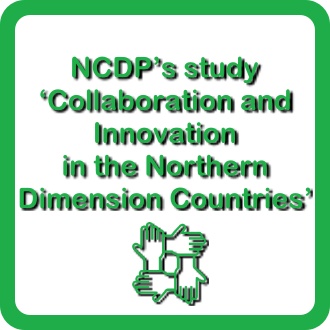
2. NCDP’s study ‘Collaboration and Innovation in the Northern Dimension Countries’
“[This study] was carried out within the framework of an EU-funded study project ‘Cross-sectoral cooperation and innovation within Creative and Cultural Industries - practices, opportunities and policies within the area of the Northern Dimension Partnership on Culture’. […] The results of the project should be of interest to policy makers […] to trigger new policy improvements and cross-innovation activities in the wider Northern Dimension innovation ecosystem.”

3. Design for policy toolkit - PROMPT
“The Design for Policy toolkit PROMPT is targeted toward policymakers who wish to identify where design can add value to the policy cycle process by enhancing user and citizen participation. The majority of the design tools included in the resource are common qualitative research and design methods and follow a gradual shift in emphasis from data-centred policy to people-powered policy, according to the publishers. PROMPT has been collaboratively developed by PDR - International Design and Research Centre in co-design workshops involving civil servants from the UK, Europe and around the world.”
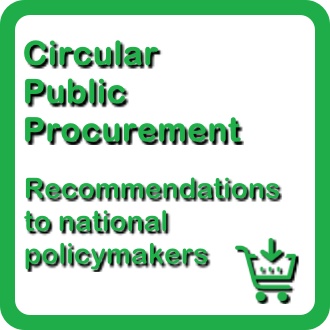
4. Recommendations to national policy-makers on Circular Public Procurement
“Circular Public Procurement (CircularPP) is a 3-year project (2017–2020) supported by the Interreg Baltic Sea Region programme. CircularPP has published recommendations to national policy-makers on circular public procurement. For example, local pilots of procurement of circular products and solutions should be encouraged, as municipalities play an important role in implementing circular economy activities and can promote the use of circular criteria.”
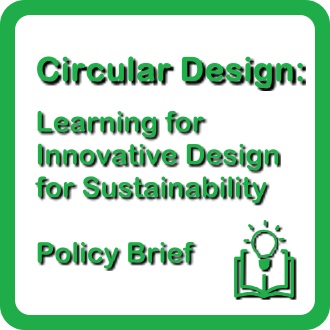
5. Circular Design: Learning for Innovative Design for Sustainability – Policy Brief
This was a European project funded by Erasmus+ within the social business and the educational innovation field.
“Circular design thinking and development should be implemented throughout all of European policies and sectors:
1. Starting with education in schools and universities.
2. Offering a lifelong learning covering all sectors, including policy makers.
3. Continuously adding high level sustainable development for all professionals and business types.”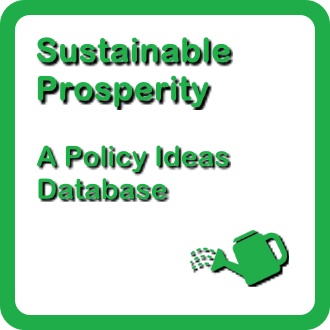
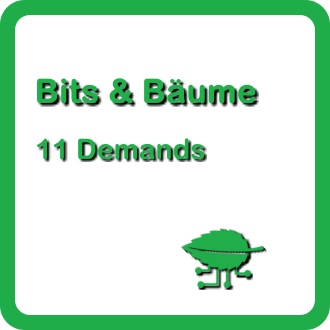
7. Bits & Bäume – 11 Demands
Bits & Bäume is a Movement for Digitalisation and Sustainability and originated in Berlin from a conference in 2018.
“What role does sustainability play for stable tech communities? Which ecological opportunities do digital applications offer for climate and resource protection? What types of digitalisation are opposed or even counterproductive to these goals? How can the digital society be democratic and just while peacefully preserving the basis of our lives on this planet?”
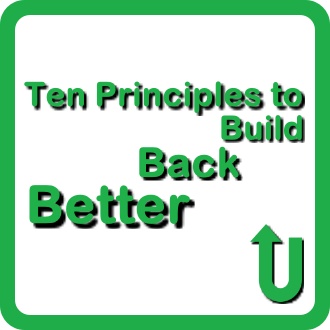
8. Ten Principles to Build Back Better
“In this briefing paper, we outline a set of ten principles for “building back better” toward a wellbeing economy. We showcase examples of inspiring actions around the world that are moving us towards a wellbeing economy, along with examples of actions that are moving us away from this vision.”
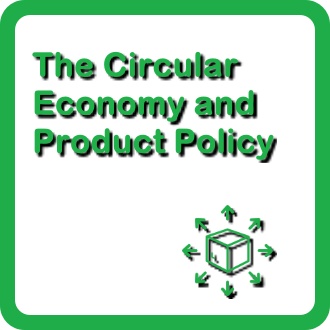
9. The Circular Economy and Product Policy
A joint research project by the Finnish Environment Institute, the University of Eastern Finland and Vrije Universiteit Brussel.
“The multidisciplinary project identified and examined in detail four areas of product policy in the rapidly evolving regulatory environment of the European Union:
1) the Ecodesign Directive,
2) extended producer responsibility (EPR),
3) product service systems (PSSs),
and 4) environmental product claims.” -

EcoDesign Circle 4.0:
POLICY RECOMMENDATIONS to Speed up Transition with Circular Design
The following recommendations are based on experiences gathered by partners of the Interreg-EU-project “EcoDesign Circle 4.0” (2019 – 2021).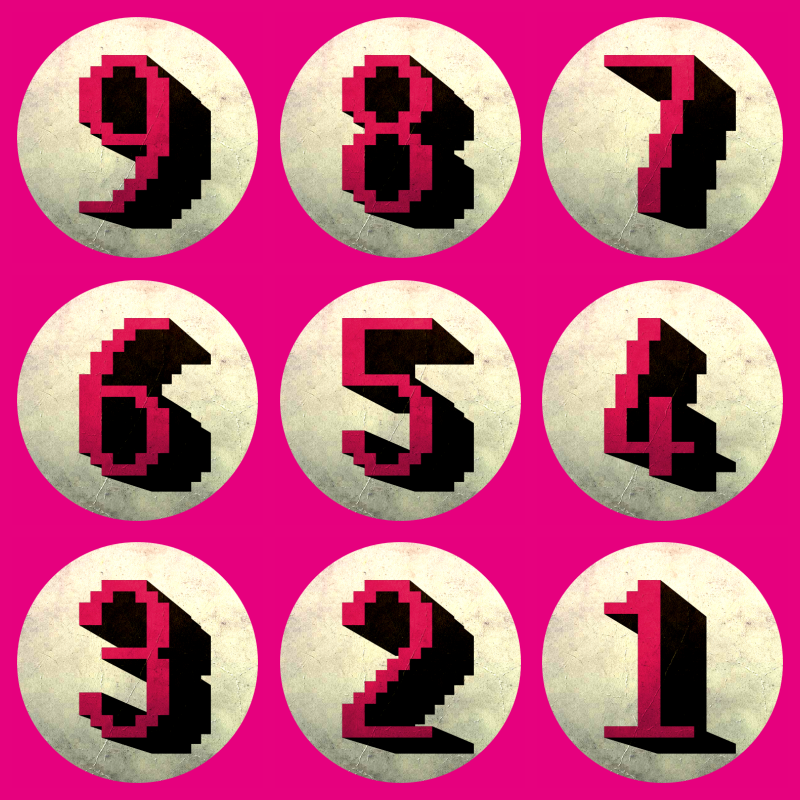
INTERESTING "NEGATIVE" NUMBERS - A COUNTDOWN Slideshow
We present a selection of "figures" and "facts" that illuminate the different aspects of our topic.
INTERESTING "POSITIVE" NUMBERS - A COUNTUP Slideshow
We present a random selection of positive figures that suggest different ways and approaches and are meant to encourage.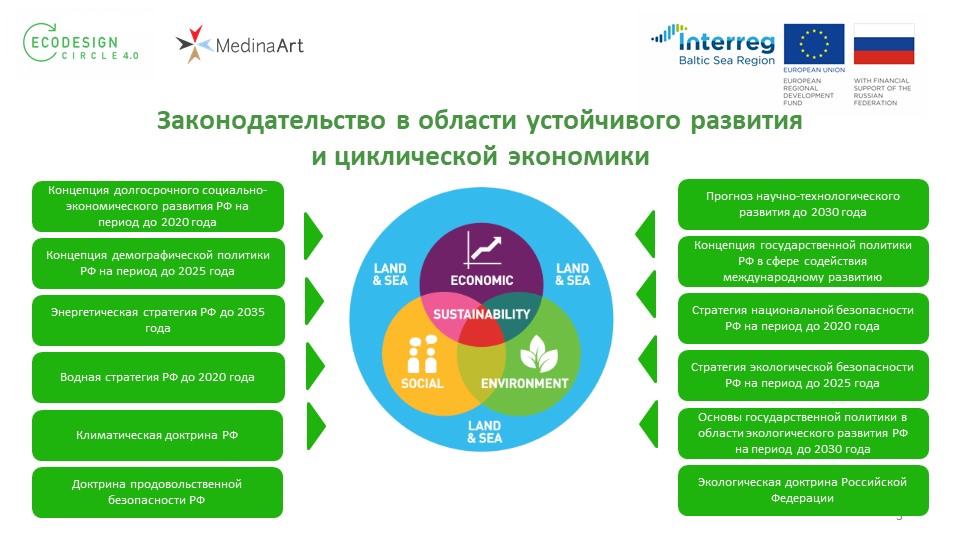
Public policy and support measures in the Russian Federation in the field of the environment, environmental protection and circular economy
English Summary of a study from Jan 2021 commissioned by EcoDesign Circle's partner Medina Art

